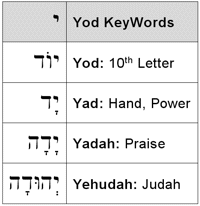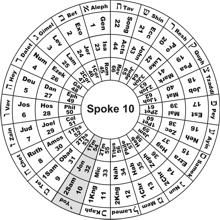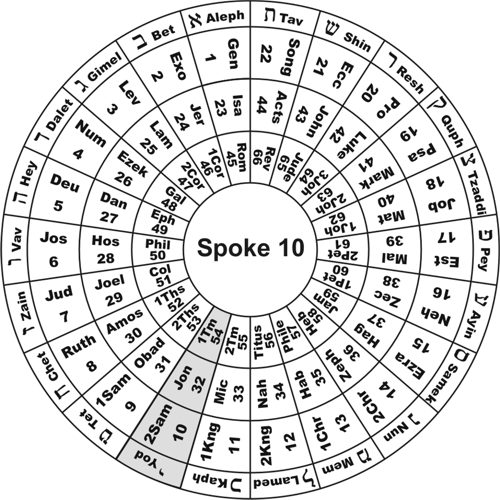The Hand of the Eternal King
Now unto the King eternal, immortal, invisible, the only wise God, be honour and glory for ever and ever. Amen.
1 Timothy 1:17 (Spoke 10, Cycle 3)
The name of the Tenth Letter is based on yad, the Hebrew word for a hand. God established its name in four Alphabetic Verses:
- AV Psalm 119:73 Thy hands have made me and fashioned me: give me understanding, that I may learn thy commandments.
- AV Proverbs 31:19 She layeth her hands to the spindle, and her hands hold the distaff.
- AV Lamentations 1:10 The adversary hath spread out his hand upon all her pleasant things:
- AV Lamentations 4:10 The hands of the pitiful women have sodden their own children:
 The
Symbol of the Hand naturally represents power, might,
ability, and authority because with it
we handle, control, possess, and manipulate (from the Latin manus = hand) everything in our world.
Indeed, yad is translated as power twelve times in the KJV and when
God gave dominion over all creatures
to Noah and his sons, he said "into your hand are they delivered." A ruling king has the
land under the "power of his hand" and God freed the Jews from their Egyptian
bondage "with great power, and with a mighty hand" (Exo 32:11). Jesus Christ asserted His
Authority as Divine Messiah when He answered the High Priest saying "Hereafter shall
ye see the Son of man sitting on the right hand of power" (Luke 22:69). Scripture routinely
speaks of the "work of his hands" as a general metaphor for all that a person does,
and in the ultimate sense for all God's work in creation, as in the Yod verse above,
"Thy hands have made me and fashioned me" (AV Ps 119:73). The
Symbol of the Hand naturally represents power, might,
ability, and authority because with it
we handle, control, possess, and manipulate (from the Latin manus = hand) everything in our world.
Indeed, yad is translated as power twelve times in the KJV and when
God gave dominion over all creatures
to Noah and his sons, he said "into your hand are they delivered." A ruling king has the
land under the "power of his hand" and God freed the Jews from their Egyptian
bondage "with great power, and with a mighty hand" (Exo 32:11). Jesus Christ asserted His
Authority as Divine Messiah when He answered the High Priest saying "Hereafter shall
ye see the Son of man sitting on the right hand of power" (Luke 22:69). Scripture routinely
speaks of the "work of his hands" as a general metaphor for all that a person does,
and in the ultimate sense for all God's work in creation, as in the Yod verse above,
"Thy hands have made me and fashioned me" (AV Ps 119:73).
This connection between Yod and Action is the basis of its two primary roles in the
Hebrew grammar (BW book pg 112). The Yod Prefix signifies the grammatical conjugation called the
"third person masculine imperfect" which is how Hebrew conveys the sense of "he does" or "he is doing" as
discussed below. The Yod Suffix signifies the "first person possessive," the sense of
me and mine.
This also is the basis of the Number 10 in the Ten Commandments which are God's fundamental
guide telling us how to act (Yod Prefix = Active Hand), with the Tenth Commandment itself,
Thou shalt not covet, relating directly to personal possession (Yod Suffix). These ideas are
dominant themes of 1 Timothy as discussed below (BW book pp 236-238).
Yod (י) is the smallest Hebrew Letter. It gave rise to the Greek Iota, called a
jot in the KJV when Christ used it as a symbol of the smallest detail of Scripture:
For verily I say unto you, Till heaven and earth pass,
one jot (iota) or one tittle shall in no wise pass from the law, till all be fulfilled.
Matthew 5:18
The words IOTA and JOT come directly from the Hebrew YOD, with
the I and J corresponding to the Y, and the T corresponding to the D (both dentals). This smallest
of Letters is the symbol of the greatest of powers. Rabbinic tradition sees this as teaching that
"greatness lies in humble self-effacement."
|



